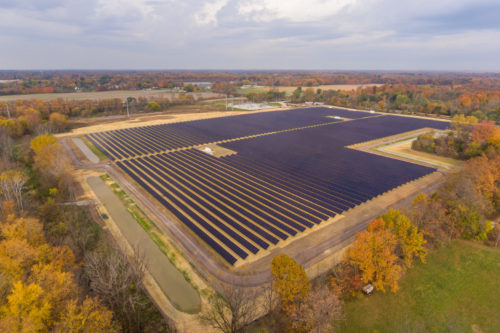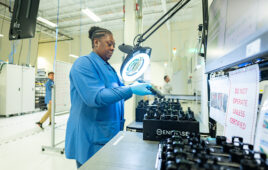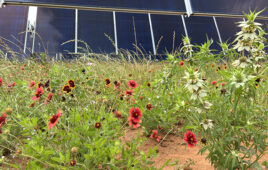As inverter technology evolves, so too does the decision whether to choose central or string inverters for utility-scale solar farms.
Central inverters “centralize” the plant’s power into one place. String combiners connect wires from each row of panels together, then recombiners combine the output of the string combiners together to feed into the central inverter. Central inverter units are physically much larger than string inverters, use longer wires and can convert more power per unit.
String inverters are a distributed architecture for solar plants. They’re small, and each unit converts a much smaller amount of power than a central inverter. There’s an inverter sited at each row of panels, so the 10-20 input strings leading from the panels to the inverters can be much shorter.
Since string inverters are converting less power for fewer panels, if one string fails, the whole array’s energy is not lost, just the power from that string. Contrast that with a central inverter, where much more power is lost if one goes down.
Central inverters are less expensive than string overall for large utility-scale installations because fewer are required per site. But for smaller utility-scale projects, string inverters could win out for their easier serviceability.
Serviceability is how easily an inverter can be repaired in case of failure. Power electronics are the aspect inherently most prone to failure in a solar installation, so inverters are likely to need servicing throughout their lifespan.
Fixing central inverters requires technical expertise that many O&M technicians don’t have, said Eric Every, product manager at Yaskawa Solectria Solar. Although some installers opt to go through central inverter maintenance training, it may be a long time until they need to actually put their skills to use, and they may have forgotten what to do when that time comes. Usually if a Solectria central inverter fails, the O&M operator has to call Solectria, work with a technician to diagnose the problem, then fly the Solectria tech out to the site to fix it. If the failure happens near the end of the year, all the techs could be booked with commissioning work, Every said.
“It’s a pretty big operation to get an inverter tech on-site with the parts that they’ll likely need with the tools that they’ll need to get you back up and running,” he said.
Contrast that process with fixing a string inverter, which is small and portable and can be done by any trained electrician. Site owners often keep spare inverters and spare kits on-site to be able to swap parts or entire inverters quickly.
“If you really need the system back up and running, you can do it,” Every said. “You’ve taken ownership of that process.”
String inverters also come with the benefit of more granular energy optimization, which is essentially the balancing of volts and amps in the power conversion. Since each unit converts power for one string instead of a larger chunk of the solar project, each inverter is better able to optimize the power for the smaller chunk, said Ed Heacox, general manager of CPS America.
“With the central inverters, they typically do large chunks, maybe 2 MW of the array, and it’s less optimal,” Heacox said.
Ingeteam manufactures both string and central inverters, so it’s unbiased about what’s best for which application. Carlos Lezana, marketing and communications for solar for Ingeteam, said the company targets the 1- to 10-MW utility-scale market with its string inverters and suggest central inverters for larger projects.
“The main advantage of the central inverters is that the cost per watt is the most optimized one,” Lezana said. “That’s the cheapest option. That’s why if you go to very large utility-scale, they always go with central inverters.”
If developers are looking for an inverter solution for a 20-MW solar plant, their option would be five to seven central inverters or hundreds of string inverters, Lezana said.
The advent of 1,500-V string inverter architecture adds some complexity to the central vs. string decision. Each inverter is processing more power—whether it’s a 1,500-V central or 1,500-V string—so that means more power is lost when one inverter goes down. However, the cost savings of the increased voltage really shine in large utility-scale arrays that use central inverters.
“The larger the scale, the greater the savings,” Lezana said. Since the upfront cost of string inverters is greater and the logistics of installing so many of them are more complicated on projects sized 10-MW and larger, central inverters will likely continue to win on very large projects, especially at a higher voltage.
Updated on Dec. 17






Hie,
I have read the full article but there is some points which want to know from you please have a look and let me know.
1. If we place the central inverter in large utility scale don’t we get the DC losses don’t we need to use large length of DC cable as we are trying to travel DC Current through the large path to the central inverter.
2. Suppose we have install 4 to 5 Central inverter at the 30MW site ok if any of the inverter will get fail due to any reason don’t you guys feel we will face large amount of power losses till then inverter will be fixed if still you want to use central inverter then what will be the solution for this generation for or power loss for that laps days of inverter till in faulty condition.
3. What are the technical aspect’s for considering during the string sizing for central invert and other BOS items.
Hope, I am looking for the positive response from you please try to revert on my mail id.
Thanks,
Shivam
Hi Shivam,
I hope you are well an safe. Can you replay to me the aswer in case they already response your question ?
Thanks
Hi all,
I have read your comments. I have a question to all. I understand string inverters are better in terms of granular maintenance, but what about the life of a string inverter, will we need to replace string inverters once or twice during 25 years of utility projects? Also please put forward your views about central inverters.
Thanks
Afternoon All,
Currently, my company is working on a large utility scale project (100+MW) where we are utilizing string inverters. The unit cost has come down and there are areas to reduce cost across the board. Look outside the box and the string inverter option is viable.
Hi Hitendra,
Hope you are doing good.
I am replying to your comments I found on Solar Power World, dated 04/06/19.
I suggest you to put all string inverters in one place for the maintenance, otherwise you have to run place to place in case of fault.
In your case, where there are different sizes of roofs and the angle may not be the same for all roofs, i suggest you to go for String inverter only.
Use the central inverter in your other projects where all the PVs are located in the same place (such as a large field) and all PVs having the same angle.
If you have already completed the project, please share me the outcomes.
Thanks
Neeraj Mathur
Dubai
+971509118023
We are working as EPC for Solar Rooftop Projects in India.
As per inquiry for solar rooftop in a factory, requirement is for 1000KW (1MW), but the roofs available are of small sizes ranging from 8000 sq ft to 15000 sq ft. I believe that we should go for 11 or 12 string inverters each of 100KW to be placed near each roof instead of going for one central inverter of 1MW.
The distance between each roof (buildings) is at least 100 meters and longest distance could be as much as 500 meters.
Let me know your views whether to go for string inverters or for central inverter in this case
Go for string inverter , because put as much less length of DC cable as possible on account of losses. After inverter you can bring AC power to your load center (MCC) of different roof tops.